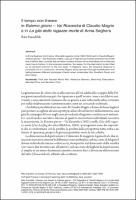Chapter Il tempo non lineare in Esterno giorno – Val Rosandra di Claudio Magris e in La gita delle ragazze morte di Anna Seghers
| dc.contributor.author | SVANDRLIK, Rita | |
| dc.date.accessioned | 2022-06-01T12:23:43Z | |
| dc.date.available | 2022-06-01T12:23:43Z | |
| dc.date.issued | 2021 | |
| dc.identifier | ONIX_20220601_9788855183383_603 | |
| dc.identifier.issn | 2420-8361 | |
| dc.identifier.uri | https://library.oapen.org/handle/20.500.12657/56418 | |
| dc.description.abstract | In Anna Seghers’ short story, Gita delle ragazze morte (1943-1944) and in Claudio Magris’ Esterno giorno – Val Rosandra (1982), a group of high school friends and their trip on the eve of World War I provide the narrative nucleus around which individual micro-histories meet macro-history. In the proposed analysis, the reason for the deprivation is identified as an element common to the two texts. In Seghers’ story, the temporal distance is cancelled out in a continuum, whereas Magris’ story operates through multiplication and fading between different typologies of texts: novel, screenplay, film, Goethe’s Faust, and short story. | |
| dc.language | Italian | |
| dc.relation.ispartofseries | Biblioteca di Studi di Filologia Moderna | |
| dc.subject.other | First and Second World War | |
| dc.subject.other | Historical Memory | |
| dc.subject.other | Mourning Elaboration | |
| dc.subject.other | Narrated Time and Narrative Time | |
| dc.title | Chapter Il tempo non lineare in Esterno giorno – Val Rosandra di Claudio Magris e in La gita delle ragazze morte di Anna Seghers | |
| dc.type | chapter | |
| oapen.identifier.doi | 10.36253/978-88-5518-338-3.08 | |
| oapen.relation.isPublishedBy | bf65d21a-78e5-4ba2-983a-dbfa90962870 | |
| oapen.relation.isbn | 9788855183383 | |
| oapen.series.number | 59 | |
| oapen.pages | 11 | |
| oapen.place.publication | Florence |

